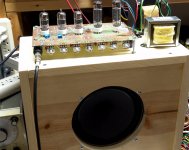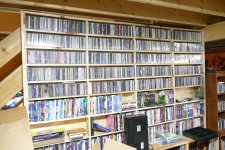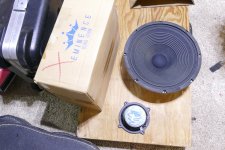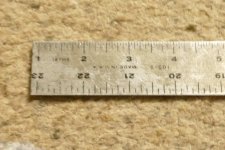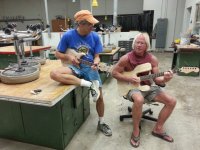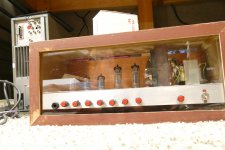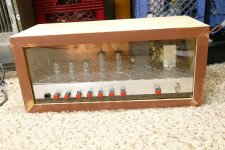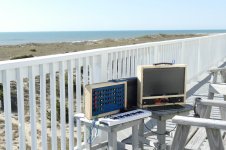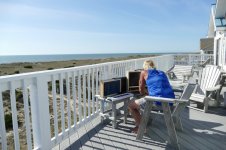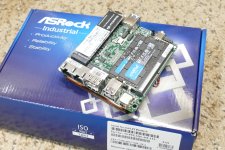You probably want lower impedance than that to gracefully deal with the impedance swing as the gm in the L6’s rise and one side goes to cutoff. Both have the effect of lowering the reflected load Z. You may even want your driver tubes to run in triode (mosfet followers dont care, they just drive it). Less gain for sure, but I’m sure you can find some other tubes to get some gain back. What kind of metal do you have in your stash to use for small signal? Or were you going to cheat and use glass there?
I guess with the power craze out of the picture for this project, you can focus more on “important” things like actually voicing the amp so you’ll still want to use it years from now.
I guess with the power craze out of the picture for this project, you can focus more on “important” things like actually voicing the amp so you’ll still want to use it years from now.
This comes back to the old "Class AB2" sucks for "real" audio applications. Triode wiring, local feedback, and light loading are all methods to tame both situations.You probably want lower impedance than that to gracefully deal with the impedance swing as the gm in the L6’s rise and one side goes to cutoff.
This is the hard part. Making more power than I need or want is easy these days. I have simply used an SSE board driven with a mosfet PI or even a transformer such that the two channels are out of phase with each other and wired a single OPT across the two channels for a 50+ watt amp. Thia is a valid option since the SSE board can also power a guitar preamp, and all of this can be done without modifying the SSE board.I guess with the power craze out of the picture for this project, you can focus more on “important” things like actually voicing the amp so you’ll still want to use it years from now.
MetallicAmp, All tube, No glass! I will make one of these just because I can and it will be different. Possibilities:What kind of metal do you have in your stash to use for small signal? Or were you going to cheat and use glass there?
Rectifier, 5T4 or 5V4
Medium signal level pentode, possible driver: 6AB7, 6AC7, or 6AG7.
Gain pentode: 6SJ7 triode wired Mu = 20
Premium gain pentode: RCA Special Red 5693 It looks neat and is somewhat rare, but I have two.
High gain triode Mu = 100: 6SF5
Low Mu triode: 6C5, 6J5
Dual triode for PI: 6SC7 or 6N7.
The guitar amp that I used in high school was a Stromberg Carlson AU36B PA amp. The only "mod" was to remove the funky "microphone" jack (same as an old RCA VTVM) and install a 1/4 inch phone jack. Plug in guitar, turn all the knobs all the way up and let it rip. That bad boy ran a pair of 5U4's for power, 4 X 6L6GA's, a 6N7 driver, a 6SC7 for the PI and a 6SJ7 for the input amp. Later versions got a 6SN7 in place of the 6N7. We didn't have any glass 6L6 type tubes in high school, but had hundreds of metal 6L6s, so that's what I used.
My "ultimate" guitar amp would be flexible with multiple paths and options. It would likely be controlled by an Arduino compatible "brain" for preset storage and recall. It would also have a big enough OPT so that I can play a bass guitar through it at a reasonable volume level.
Thanks! I'd once played with - I think - a class D amp output to drive cathodes. My thinking went "so with +24V supply, each of the BTL outputs sits at ~12V above ground. As the input signal goes, say, +, one output goes +, the other goes -. Hence the bridge. A 6BQ5 should be happy with its cathode 12V above a grounded grid - depending on the other B+ voltages, but generally.It involves standing a p-channel mosfet on its head and using it as a follower to drive the cathode of an output tube while "triodization" or Schade feedback is applied to the control grid via a simple resistive divider from plate to ground.
Of course whatever output filter in the class D amp would have to be messed with, as you wouldnt want 12V DC sitting quiescent across 8 Ohms or so the value the stock output filter is designed to work with. You'd have to change the L and C values to match a better choice of R, in such a scheme. Or perhaps an entirely different arrangement could be designed for the filter, when cathode driving a tube with PWM.
So thinking Raspberry pi streamer, one of those "hat" class D amps --> a set of output tubes, for less power than the class D would do, all by itself. Why, WHY? I guess because you could go through all the calculations, ruin the little amp for later speaker use, having nothing better to do, because no one else has. It'd look pretty. I didnt comprehend the Schade feedback part, which would certainly be a selling point, if not an actual improvement to its sound.
I ruined one little hat already, @ $50. I bought a second, which sits in the box. Should have sold it and the pi 3 when prices were up - those windows of opportunity just keep flying by ;')
Likewise, unsure of what Guitar -> Scarlet -> USB -> Computer -> USB -> I2S -> Class D amp -> Tubes 'n Transformers would buy you sound wise, with most of that happening in the computer already. Seems like a substitution of tubes 'n transformers for the output filter in the class D amp. Move the conversion back to analog a bit further downstream. Yet, someone might buy it...maybe.
I have considered using the primary winding of a push-pull transformer as an interstage autoformer for driving a p-p output stage.. Electra-Print used to be a source for a push-pull interstage autoformer, but no more. I have two of the Electra-Print transformers in question, of uncertain pedigree. What I need to do is throw them on the bench to characterize them.
Last edited:
I have a dedicated PC for musical experimentation, from tinkering with a DAW like Ableton Live (complex and powerful) and Mixcraft 10 (Easy to learn good enough for general use) to running a full on VIRTUAL modular music synthesizer, VCV Rack, the FREE version is very good and quite powerful, but it does need some CPU power and a video card, ANY video card in the PC.Likewise, unsure of what Guitar -> Scarlet -> USB -> Computer -> USB -> I2S -> Class D amp -> Tubes 'n Transformers would buy you sound wise, with most of that happening in the computer already. Seems like a substitution of tubes 'n transformers for the output filter in the class D amp. Move the conversion back to analog a bit further downstream. Yet, someone might buy it...maybe.
The "music PC" has a Focusrite interface with eight audio channels, one of which always has a guitar cable stuck into it. Two of its outputs go to Class D powered Studio Monitors. The speakers can get quite loud without distortion, and the white pilot lights will blink red on peaks to tell you where the limit is. Wind the knob further to the right and the speakers will flip you the bird by simply shutting down for a few seconds while the light blinks red. Anyone else ever own a Carver M-400 cube? It used to give me the same treatment when I pushed it beyond the redline. Yes, despite the warnings from Carver, I plugged a guitar preamp into the Carver and used it to blast the neighbor kid out of the tree in his front yard where he used to play rap crap on his boom box. Several years later he retaliated by forming a death metal band called Sickness. His little Peavey combo amp could not compete in the loudness wars though.
This setup gets used for simple practicing and non serious guitar play which is pretty much all I can do now, so I really don't need a new guitar amp at all. Something inside my head keeps pushing me to make one or two though. I think the MetallicAmp would be cool especially if I could come up with some sort of Steam Punkish case for it. As for the ultimate amp, I don't plan on using a PC, as I can do that already, but there will be an FX loop which could accommodate one if needed.
Right now I'm looking through my transformer collection for something that has a pair of 120 volt windings and a pair of say 12 to 24 volt windings. So far I have found several transformers with one of those winding sets, but not both on the same transformer.
I got some arth in my left index; hurts more on some days than others. Lately I play a softer guitar too, the nylons that I can still strum out a tune with. Sometimes in my YT sojourns, its AI will present something that I think I can make work; I'll look up the chords on line, rip the YT audio as a mp3 to practice along with, if I think I can make it go.This setup gets used for simple practicing and non serious guitar play which is pretty much all I can do now,
Found this one this morning; yeah - I think I can do that. I usually format them to fit on 1 page if possible, print them out and put them in a binder. The mp3s in a folder. After awhile of routinely working though what's filling up the book, I start to surprise myself. Something like "Beyond the Sea" actually seems within possibility, with that smooth F-Dm-Gm-C7 shuffle.
Lately, I've also been challenging myself to sit in a spot at a Friday evening open mic for 3 songs. As bad as I "suck", I notice most everyone else there is my age, ugly too, makes mistakes, cant sing either - so I fit in well. My playing improves, week over week. Eddie's song below is nice n short; gets me off the stage and back into the audience quick with 3 songs like that. Last time I was done so fast the guy running the mixer asked if I'd even played 3 songs...
I Remember - Eddie Cochran.
INTRO: C Am F G7 (x2)
[1]
G7 C Am F G7 C Am F
I keep thinkin'......hopin' and prayin'..
G7 C Am F G7 C Am F G7
that you will remember.....and come back to me.
[2]
G7 C Am F G7 C Am F
When you remember......the happiness of our past..
G7 C Am F
do you think this heartache will last?
G7 C F C C7
Remember, oh, yes.
CHORUS:
F G7
If love's a game, for you can't win
F G7 C C7
remember, I lost, losing you.
F G7
If you find, in time, your love is mine..
D G7
come back, I'll be waiting for you.
[3]
G7 C Am F G7 C Am F
I keep thinkin'......hopin' and prayin'..
G7 C Am F G7 C F C
that you will remember.....and will come back to me.
Last edited:
I just picked up another pair of the Electra-Print interstage autoformers - a matched pair this time. Jack appears to be selling off his residual stock of output and interstage transformers. I'll characterize them when they come in. I have a mismatched (maybe, they don't look alike from outside appearances) pair of the autoformers floating around in my junk heap. Those will get their turn on the bench as well. Maybe they'll test as alike as peas in a pod...
One small step forward......towards the scrap bin.
Back during the Hundred Buck Amp Challenge I knocked together a simple open back speaker cabinet with an 8 inch Jensen guitar speaker. It was used for comparative amp testing during the challenge and for casual guitar playing at bedroom friendly volume levels. When I had to leave Florida permanently on 3 weeks notice, the cabinet went into the trash and the speaker driver went into a box full of oddball speaker drivers and other "woodshop" stuff. The amp board seen on top of it survived the trip and is now in a cabinet and operational.
Last winter Sherri and I got a bunch of wood at a discount when a local "home improvement" store decided to clean out all the ugly stuff left in their bins. We used it to build the "wall of sounds" There was a considerable pile of lumber left from that project. Yesterday was a sunny day with the temperature hovering around 45 degrees F without the crazy wind we have had.......table saw time!
I decided to make a cabinet with some of the leftover wood that was similar to the discarded HBAC cabinet, but just big enough to house both a 12 inch Eminence guitar speaker and a 5 inch Jensen MOD speaker. I mocked it up in Visio, drew up a cut sheet list, and hit the saw. Unfortunately, when I brought the cut wood into the basement and began to arrange the stuff on the work table the speakers would not fit. It seems that all my cut wood pieces were about an inch too short. WTF? Could there be something wrong with my measurements?
My 2 foot long ruler came out of the box full of oddball speaker drivers and guitar parts that had not been opened since I went to a weekly wood shop class in Florida over 10 years ago. I vaguely remember an incident with the metal shear..... I guess I'll be back at the saw today. I did find the body of the DIY guitar I made in that class along with a few other DIY guitar bodies. The neck is still MIA, but there is another box marked "woodshop guitar parts."
I may complete the "screw-up" box build any way and reuse the 8 inch Jensen, or some other drivers that I have.
On the electronics front I have been working on an LT spice simulation of a gain stage that is the spawn of an UNSET stage and the Saturator stage I developed for the HBAC. I started a little perf board proto build of the single stage but haven't built enough to test anything yet.
Back during the Hundred Buck Amp Challenge I knocked together a simple open back speaker cabinet with an 8 inch Jensen guitar speaker. It was used for comparative amp testing during the challenge and for casual guitar playing at bedroom friendly volume levels. When I had to leave Florida permanently on 3 weeks notice, the cabinet went into the trash and the speaker driver went into a box full of oddball speaker drivers and other "woodshop" stuff. The amp board seen on top of it survived the trip and is now in a cabinet and operational.
Last winter Sherri and I got a bunch of wood at a discount when a local "home improvement" store decided to clean out all the ugly stuff left in their bins. We used it to build the "wall of sounds" There was a considerable pile of lumber left from that project. Yesterday was a sunny day with the temperature hovering around 45 degrees F without the crazy wind we have had.......table saw time!
I decided to make a cabinet with some of the leftover wood that was similar to the discarded HBAC cabinet, but just big enough to house both a 12 inch Eminence guitar speaker and a 5 inch Jensen MOD speaker. I mocked it up in Visio, drew up a cut sheet list, and hit the saw. Unfortunately, when I brought the cut wood into the basement and began to arrange the stuff on the work table the speakers would not fit. It seems that all my cut wood pieces were about an inch too short. WTF? Could there be something wrong with my measurements?
My 2 foot long ruler came out of the box full of oddball speaker drivers and guitar parts that had not been opened since I went to a weekly wood shop class in Florida over 10 years ago. I vaguely remember an incident with the metal shear..... I guess I'll be back at the saw today. I did find the body of the DIY guitar I made in that class along with a few other DIY guitar bodies. The neck is still MIA, but there is another box marked "woodshop guitar parts."
I may complete the "screw-up" box build any way and reuse the 8 inch Jensen, or some other drivers that I have.
On the electronics front I have been working on an LT spice simulation of a gain stage that is the spawn of an UNSET stage and the Saturator stage I developed for the HBAC. I started a little perf board proto build of the single stage but haven't built enough to test anything yet.
Attachments
My first inclination was to destroy it, but it was stronger than I am, but it was a bit bent out of shape when it went into the trash bag.
Tone test already lives in a box. I had forgotten all about the tone test board which was built for the Hundred Buck Amp Challenge back in mid 2011. Turns out that I liked it enough back then to make a box for it. All that stuff got shoved into boxes when we had to get out of the house we lived in for 37 years on three weeks notice. The amp is now alive, and since Parts Express is having a 14% off sale that ends today,, I ordered a couple cheap speakers and some black Duratex speaker cabinet paint. Tone test will have a fresh coat of paint on that ugly box. I cut a lot of wood today. There may or may not be one or two new guitar speaker cabinets in my future, depending on how much I screwed up.
Tone test already lives in a box. I had forgotten all about the tone test board which was built for the Hundred Buck Amp Challenge back in mid 2011. Turns out that I liked it enough back then to make a box for it. All that stuff got shoved into boxes when we had to get out of the house we lived in for 37 years on three weeks notice. The amp is now alive, and since Parts Express is having a 14% off sale that ends today,, I ordered a couple cheap speakers and some black Duratex speaker cabinet paint. Tone test will have a fresh coat of paint on that ugly box. I cut a lot of wood today. There may or may not be one or two new guitar speaker cabinets in my future, depending on how much I screwed up.
Attachments
I needed some Acry-Tech Duratex coating to paint some speaker and guitar amp boxes. I used the stuff in Florida when I could drive over to the manufacturer and get it cheap. Now the going rate is $45 to $50 per quart. Parts Express charges $45, so I needed "$5 more to get free shipping" and took the bait. I got a GRS 10PT-8 which is a "pro audio" woofer that can allegedly eat 200 watts RMS. My "screw-up" speaker box that came out a bit too small for what I had in mind might work with a 10 inch speaker, but I have none. PE wanted too much money for anything called a guitar speaker, so I went for the cheapest 10 inch speaker they had, the $29 GRS10PT-8.
The speakers containing a pair of 6 inch drivers and a bullet tweater (disabled for guitar use) seen in the third picture in post #36 are Dayton PA165's. I built those cabinets 10 to 12 years ago and coated them in Duratex which has held up well. The drivers are Dayton PA165's and they have also eaten everything I throw at them, including rock group PA duty being fed with a 125 WPC version of Pete Milletts big red board. PE had a "restocked" PA 165 for $17, so hopefully it works.
Now that I have glued up the front baffle boards for two cabinets, it looks like a single 12 inch speaker will fit the "screw-up" cabinet and I have a pair of 12 inch Eminences that have been in their boxes for over 10 years. a single 12 inch guitar speaker, or the 10 inch and 6 inch pair that I will have when the USPS brings them. I need to look at the pile of leftover wood to see what's left, and what I can make with the remains, but the weather rules out table saw time for tomorrow. I use a folding job site table saw on my driveway and it's 100% chance of rain for tomorrow. Decisions, decisions, decisions.
Back in post #30 I posted pictures of a "B52 100 watt All Tube" combo guitar amp chassis that I was in the process of stripping. I don't think it got past the point of no return before I stuck it on a shelf. Maybe I'll make a box to turn that thing into a head. I didn't like the sound, but it has a bunch of 12AX7's and 4 6L6GC's. It should be possible to turn it into a Fender clone and have lots of stuff left over!
The speakers containing a pair of 6 inch drivers and a bullet tweater (disabled for guitar use) seen in the third picture in post #36 are Dayton PA165's. I built those cabinets 10 to 12 years ago and coated them in Duratex which has held up well. The drivers are Dayton PA165's and they have also eaten everything I throw at them, including rock group PA duty being fed with a 125 WPC version of Pete Milletts big red board. PE had a "restocked" PA 165 for $17, so hopefully it works.
Now that I have glued up the front baffle boards for two cabinets, it looks like a single 12 inch speaker will fit the "screw-up" cabinet and I have a pair of 12 inch Eminences that have been in their boxes for over 10 years. a single 12 inch guitar speaker, or the 10 inch and 6 inch pair that I will have when the USPS brings them. I need to look at the pile of leftover wood to see what's left, and what I can make with the remains, but the weather rules out table saw time for tomorrow. I use a folding job site table saw on my driveway and it's 100% chance of rain for tomorrow. Decisions, decisions, decisions.
Back in post #30 I posted pictures of a "B52 100 watt All Tube" combo guitar amp chassis that I was in the process of stripping. I don't think it got past the point of no return before I stuck it on a shelf. Maybe I'll make a box to turn that thing into a head. I didn't like the sound, but it has a bunch of 12AX7's and 4 6L6GC's. It should be possible to turn it into a Fender clone and have lots of stuff left over!
I saw a YouTube video about "the future of guitar rigs" today and I'll have to admit that I may go down a similar route, again. The video is here:
I must admit that I watched about 5 minutes and realized that this is just a fancy "all in one PC" with a built it audio interface. I immediately jumped over to the manufacturers page and checked out the price, $800 for a preorder, they are not even shipping yet.
The picture shows something similar to, but much smaller than a rig that I built about six years ago. it's seen here on a vacation trip overlooking the Atlantic ocean and running on battery power, a rather heavy UPS. No wimpy Celeron chip in mine, I ran a Core i7-7700T (low power) CPU chip in a Mini ITX motherboard which fed a 19 inch 1920 X 1080 Dell monitor. Audio came from the motherboard outputs through a 10 WPC TI class D chipamp feeding speakers on the front of the unit. Audio input was done using a MOTU Micro Book II, which has a useful "guitar" input on the front as well as the typical XLR / 1/4 inch Mic jack. MIDI I/O was done in the Arturia Keystep which also does MIDI to CV/Gate to feed the virtual analog synth. The Core i7 CPU was powerful enough to run a serious DAW like Ableton live, or a virtual guitar rig like Overloud's TH-3. I dragged this thing around on several vacation trips for a couple of years.
A few years ago I got a laptop that was powerful enough to do the same stuff, so the "Box PC" was mined for parts. The nearly empty shell still resides under a workbench.
I used the word "again" in my first sentence. Why? Because Newegg decided to blow out their remaining stock of this AsRock Industrial motherboard with a Ryzen 7-7735 CPU installed for $150. I took that bait, installed a SSD that I robbed from another machine and some cheap Laptop memory from Amazon. This thing will run everything that I throw at it with a the exception of VCV Rack, the virtual modular synthesizer which requires a dedicated video card in the machine to avoid interrupt contention. VCV Rack does run good but I can't load a really complex patch without some occasional glitches. I did however load up TH-U and plugged in the MOTU and fed it's output to the same SPP board I have been using for some of these guitar amp experiments. It ROCKS and does 60's surf music pretty well too. I think that there will be another Box PC in my future, but it will be laid out differently and have a better audio and MIDI I/O, probably a Focusrite Scarlett 4i4, since there is one sitting idle on here at the moment.
https://www.newegg.com/asrock-industrial-4x4-7735u-d5/p/N82E16813301015
As predicted, all the wood parts that I cut yesterday did not quite fit together, so tomorrow is belt sander day. I did decide to go with a single 12 inch Eminence guitar speaker.
I must admit that I watched about 5 minutes and realized that this is just a fancy "all in one PC" with a built it audio interface. I immediately jumped over to the manufacturers page and checked out the price, $800 for a preorder, they are not even shipping yet.
The picture shows something similar to, but much smaller than a rig that I built about six years ago. it's seen here on a vacation trip overlooking the Atlantic ocean and running on battery power, a rather heavy UPS. No wimpy Celeron chip in mine, I ran a Core i7-7700T (low power) CPU chip in a Mini ITX motherboard which fed a 19 inch 1920 X 1080 Dell monitor. Audio came from the motherboard outputs through a 10 WPC TI class D chipamp feeding speakers on the front of the unit. Audio input was done using a MOTU Micro Book II, which has a useful "guitar" input on the front as well as the typical XLR / 1/4 inch Mic jack. MIDI I/O was done in the Arturia Keystep which also does MIDI to CV/Gate to feed the virtual analog synth. The Core i7 CPU was powerful enough to run a serious DAW like Ableton live, or a virtual guitar rig like Overloud's TH-3. I dragged this thing around on several vacation trips for a couple of years.
A few years ago I got a laptop that was powerful enough to do the same stuff, so the "Box PC" was mined for parts. The nearly empty shell still resides under a workbench.
I used the word "again" in my first sentence. Why? Because Newegg decided to blow out their remaining stock of this AsRock Industrial motherboard with a Ryzen 7-7735 CPU installed for $150. I took that bait, installed a SSD that I robbed from another machine and some cheap Laptop memory from Amazon. This thing will run everything that I throw at it with a the exception of VCV Rack, the virtual modular synthesizer which requires a dedicated video card in the machine to avoid interrupt contention. VCV Rack does run good but I can't load a really complex patch without some occasional glitches. I did however load up TH-U and plugged in the MOTU and fed it's output to the same SPP board I have been using for some of these guitar amp experiments. It ROCKS and does 60's surf music pretty well too. I think that there will be another Box PC in my future, but it will be laid out differently and have a better audio and MIDI I/O, probably a Focusrite Scarlett 4i4, since there is one sitting idle on here at the moment.
https://www.newegg.com/asrock-industrial-4x4-7735u-d5/p/N82E16813301015
As predicted, all the wood parts that I cut yesterday did not quite fit together, so tomorrow is belt sander day. I did decide to go with a single 12 inch Eminence guitar speaker.
Attachments
My initial reaction to the concept of a Windows based guitar amp is similar to the two fellows expressions in the first 3 minutes or so. But it's just the paradigm grating on me; someone born well outside when I was could feel completely different; there's a computer in everything; what else is there, why would I even bother with classical passive and active single function components? So stone age...
I think its loosely connected to "Who's going to value these million dollar vintage instruments, once all the boomers have passed on? The vintage guitar market is going to crash"
Anyway, I applaud you for burning both ends of the stick; Analog master at one end, yet responding with time, money and effort to the digital attraction and building something using a functional arrangement of those components and software.
I think its loosely connected to "Who's going to value these million dollar vintage instruments, once all the boomers have passed on? The vintage guitar market is going to crash"
Anyway, I applaud you for burning both ends of the stick; Analog master at one end, yet responding with time, money and effort to the digital attraction and building something using a functional arrangement of those components and software.
Whatever DIY guitar amp I finally settle on, there will be an FX loop capable of running a clean signal out to an external device that could be a PC or a pedalboard for further processing. I have a 30 inch tall reverb tank from an old Hammond tone cabinet. That must be stood upright to function, so it must be external to the amp.
There is still no substitute for cranking up a real tube guitar amp. Even so, most of my random 5 to 15 minute guitar practice sessions are done with the other end of the guitar cable stuck into my Focusrite. Why? because I can call up a backing track in a simple DAW to play along with. If I feel like being punished, I can record the result and listen to my lousy playing.
Acoustica's Mixcraft is a good DAW for a bargain price. It's also relatively easy to learn. They are currently at version 10, but Mixcraft 9 can often be found in a bundle deal for $35 or less. I got a "Humble Bundle" last year that included Mixcraft 9 and over 10 GIGABYTES of loops and samples for $35.
Many years ago Peavey bought a European software amp modelling company and rebranded their product as the Peavey Revalver, a tube amp modeler. Its unique aspect kept me occupied for several months. You could call up a particular Peavey amp, and a few other popular non Peavey amps, select the SCHEMATIC view and play with component values and a limited tube choice. You could then play the result. You could make some really nasty sounding (not always in a good way) amps by running several parts up against their rather wide preset limitations. I know that this was possible in Revalver 3 and Revalver 4. Peavey has since sold the product to HeadRush who now offers Revalver 5 as a free download, but sells all the popular amp models separately. I found a vague screenshot on a YouTube video of a schematic in Revalver 5, but I don't know if all the old schematic tweakability is still supported.
There is still no substitute for cranking up a real tube guitar amp. Even so, most of my random 5 to 15 minute guitar practice sessions are done with the other end of the guitar cable stuck into my Focusrite. Why? because I can call up a backing track in a simple DAW to play along with. If I feel like being punished, I can record the result and listen to my lousy playing.
Acoustica's Mixcraft is a good DAW for a bargain price. It's also relatively easy to learn. They are currently at version 10, but Mixcraft 9 can often be found in a bundle deal for $35 or less. I got a "Humble Bundle" last year that included Mixcraft 9 and over 10 GIGABYTES of loops and samples for $35.
Many years ago Peavey bought a European software amp modelling company and rebranded their product as the Peavey Revalver, a tube amp modeler. Its unique aspect kept me occupied for several months. You could call up a particular Peavey amp, and a few other popular non Peavey amps, select the SCHEMATIC view and play with component values and a limited tube choice. You could then play the result. You could make some really nasty sounding (not always in a good way) amps by running several parts up against their rather wide preset limitations. I know that this was possible in Revalver 3 and Revalver 4. Peavey has since sold the product to HeadRush who now offers Revalver 5 as a free download, but sells all the popular amp models separately. I found a vague screenshot on a YouTube video of a schematic in Revalver 5, but I don't know if all the old schematic tweakability is still supported.
It's another one of those asymptotic things, like HiFi itself. Spend more, more compute horsepower, work those software algorithms to death and you're get a little bit closer to "fine". I just read a reviewer's opinion that within a recording, most players wouldnt note a difference (using that ReValver), but the guy still says for live, he prefers the interaction he gets between fingers, guitar and hardware amp.There is still no substitute for cranking up a real tube guitar amp.
That gap will close further, as people spend time, effort and money on the "problem". Besides, it's fun!
Edit: I forgot to mention how amusing that these software simulators seemingly have to begin to mix engineering and musicianship. "SchemAccurate" and such terms. I still take Dave Grohl's response to when he asked the designer of that board he pulled from Sound City "what makes it sound that way" as average.
Most musicians arent going to comprehend "leakage inductance"; heck I've never properly grasped that one and I'm an EE. Yet, the guy that deigned the board was explaining that property of the transformers he used is part of the board's sound. So maybe they'll have a leakage inductance property in the output transformer of a schematic based amp simulation one day, if not already.
Last edited:
Leakage inductance in lumped equivalent transformer models has been there for ages. It represents the flux which is not mutually linked through both the primary and secondary windings. The linked flux gives rise to the magnetizing/mutual inductance. In the lumped equivalent model below L1 is the primary leakage inductance, and Lm is the magnetizing/mutual inductance. L2 is the secondary leakage inductance.So maybe they'll have a leakage inductance property in the output transformer of a schematic based amp simulation one day, if not already.
Thanks Mark. How that relates to the sound of a channel using transformer coupling? Apparently whatever it does is a desired effect.It represents the flux which is not mutually linked through both the primary and secondary windings.
I suppose the schematic Mark posted could be made available to a user of such a schematic based simulation. With the "wild" limits on component values to give sounds perhaps not possible using real hardware components.He meant the simulator inside a schematic modelling guitar amp.
Some of the leakage flux passes through some of the iron in the core and some of it passes though surrounding air and other materials. It acts more like an typical inductor, but it may have some of iron sound of core (hysteresis distortion, B-H nonlinearity, eddy losses, etc.).
- Home
- Live Sound
- Instruments and Amps
- Tubelab wants a new guitar amp
